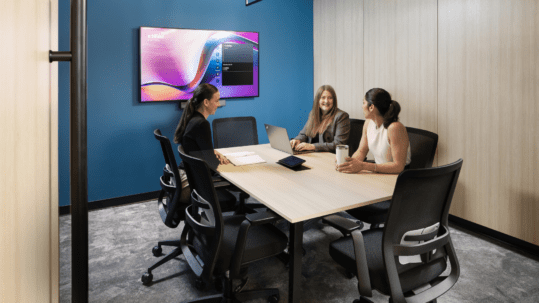As COVID19 appeared to completely disrupt our everyday lives, we were forced to revisit how we work and where we work. We’ve seen leading companies like Twitter welcome a whole new chapter by allowing employees the option to work remotely, part-time or even permanently. Other firms have gradually returned to their physical office but with drastically new ways of working.
I was particularly interested in what comes after “the new normal”, call it “the next normal”. What will work environments and physical office spaces look like in the world post-COVID, post-vaccine, 3-5 years from now?
So I asked around.
My team and I surveyed over 200 Vancouver executives to understand their thoughts, ideas, and fears as they pertain to the future—and we got some good insight.
Office spaces will shrink over time
68% of respondents said that in the future, their teams will be working from home 2-3 days a week. This isn’t surprising since giving staff the option of working from home is a key way to stay relevant as a great place to work. When you allow your workforce to work from home, you’re giving them better work/life balance and helping them save on commuting time, usually translating into improved productivity.
Knowing that a chunk of office space then becomes empty a few days a week, we then asked executives if they thought their employees would be using more space within the office than they did before. Less than half agreed that more space will be used per employee even with the scare of this pandemic. With desks taking up as much as 70% of traditional office spaces, independent work such as checking e-mails or writing reports could be done from home. Essentially, this means that office spaces will shrink over time.
This is great news for Vancouver businesses that enjoy the thriving tech environment our city has to offer but at the crippling cost of rent prices per square footage. We will now have a new opportunity to cut those overhead costs spent on underutilized space and invest them elsewhere for growth.
Our conversations with tech companies proved just how confident tech companies were in their ability to grow significantly without needing more office space. They reported that they could still communicate well from home, access their resources easily, learn to onboard new employees online half the time, and have staff develop their careers in the same ways from the comfort of their own homes. They also weren’t worried about their culture suffering being away from the physical office space half of the week.
Offices become activity-based destinations
This isn’t to say that office spaces will go away completely. We still found a need for office spaces given the unique benefits they bring to collaboration, that aren’t always possible over conference calls.
Tech firms have been ahead of the curve for a whole decade by adopting split collaboration and remote work styles. This is what we’ll start to see a lot more of. Instead of having entire floors filled with rows of desks, instead offices will become destinations for activity-based work. They’ll become places where staff can go for meetings and brainstorming sessions while still having the option of returning home to perform their individual focus tasks.
Technology will foster controlled office environments
With activity-based working, rather than staff having personal workstations, the office will instead provide numerous workstations. Technology will play a key role in managing this new agile environment.
Our research found that the speed of technology to support remote work will quintuple and bring along new ways of using spaces. For example, hot desk booking apps like Condeco and Skedda have already come to market to facilitate the booking process of these workstations and offer controlled environments by limiting the number of workers in the space at a given time. Booking is done ahead of time on some occasions and others allow drop in any time. Some of these technologies even use seat sensors to notify app users whether someone is currently occupying the desk or not.
Not one size fits all
What we’ve learned overall is that the future tech office space can take many different forms. We met with more progressive companies that aim to transition to fully remote environments and use a central hub like a cafe, restaurant, or country club for their in-person collaboration. Other companies are a little more resistant to drastic changes. They’re willing to let employees work from home 20% of the time, but with business as usual otherwise. And then there are the companies that fall in between to offer hybrids between work from home and work from office models.
Whichever route you’re leaning towards, it’s time to get HR on board to structure a new workplace strategy that will address the safety of your staff, dictate what’s appropriate for working at home and in office, and future-proof your company for the next pandemic.
My advice for now? Start going through the process of defining your own appetite for change before deciding how you’re going to alter your organization. Once you have an idea of which model you’re leaning towards, make sure you consult with experts before making any changes. Workplace strategists have the tools and knowledge to assist you in navigating your “next normal”.
Each company’s needs are unique, but the opportunity to better use our spaces and plan for efficiency and safety post-pandemic are endless.
If you’d like to see the full results from our research or need to speak to a consultant feel free to contact us.
Dan Boram | CEO
This content was first published on Techcouver.






